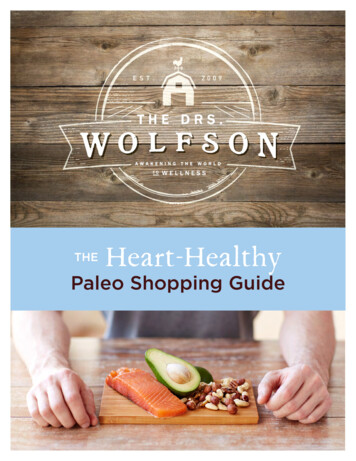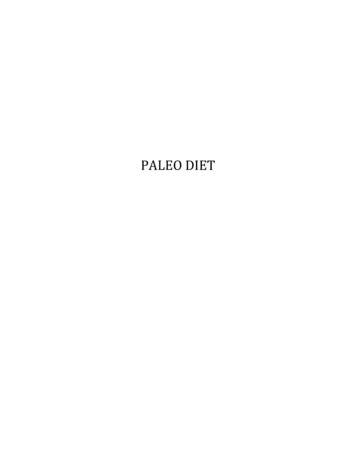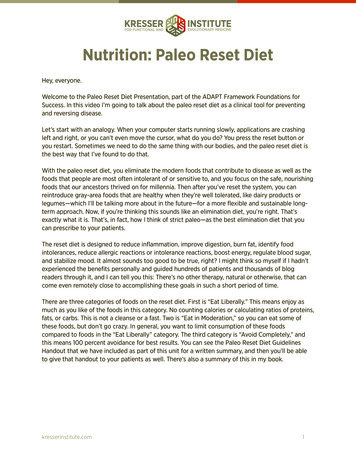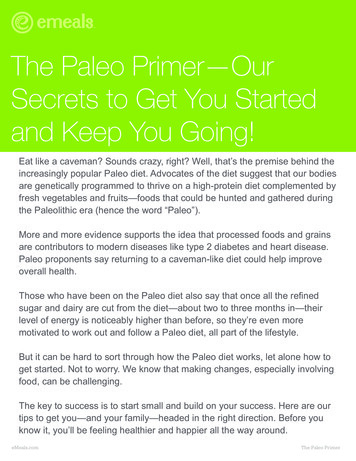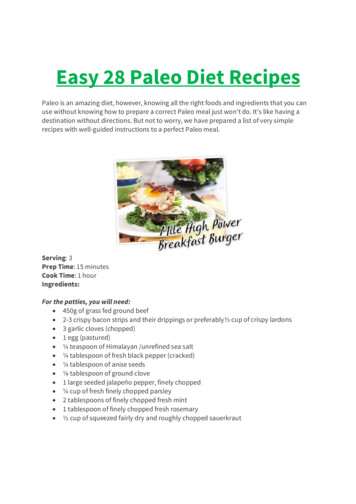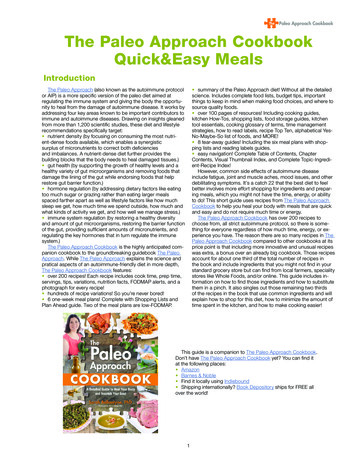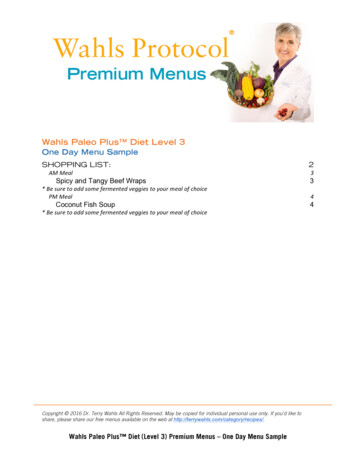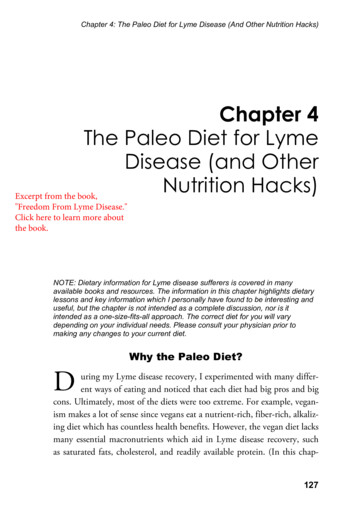
Transcription
Chapter 4: The Paleo Diet for Lyme Disease (And Other Nutrition Hacks)Chapter 4The Paleo Diet for LymeDisease (and OtherNutrition Hacks)Excerpt from the book,"Freedom From Lyme Disease."Click here to learn more aboutthe book.NOTE: Dietary information for Lyme disease sufferers is covered in manyavailable books and resources. The information in this chapter highlights dietarylessons and key information which I personally have found to be interesting anduseful, but the chapter is not intended as a complete discussion, nor is itintended as a one-size-fits-all approach. The correct diet for you will varydepending on your individual needs. Please consult your physician prior tomaking any changes to your current diet.Why the Paleo Diet?During my Lyme disease recovery, I experimented with many different ways of eating and noticed that each diet had big pros and bigcons. Ultimately, most of the diets were too extreme. For example, veganism makes a lot of sense since vegans eat a nutrient-rich, fiber-rich, alkalizing diet which has countless health benefits. However, the vegan diet lacksmany essential macronutrients which aid in Lyme disease recovery, suchas saturated fats, cholesterol, and readily available protein. (In this chap127
Freedom From Lyme Disease by Bryan Rosnerter, we will see why these nutrients are so important). Even vegetarianism,it turns out, is usually too extreme and doesn’t provide the nutrientsneeded to power a recovery from chronic illness.But let’s not throw the baby out with the bathwater. Let’s keep thebenefits of eating a vegan diet without completely eliminating the otherrequired macronutrients found in other diets. This logic is what guidedmy selection of an eating plan. I like to think that I’ve taken the best ofmany diets and combined them all into one. Only, I don’t get to takecredit for this kind of diet, as it wasn’t really my idea. The diet is knownas the Paleo Diet, and it’s quite popular across America right now.The fundamental premise of the Paleo Diet is that over the last 200years, the human diet has changed more than it has in the previous 5,000years due to the advent of agriculture and food processing technology.The Paleo Diet advocates eating a diet which predates these developments. Paleo proponents argue that our bodies aren’t designed to handlethese new modern food changes. While many people view the Paleo Dietas just another fad, it is far from that. In fact, it’s one of the oldest dietson planet Earth (hence, it’s name), as it advocates eating foods which aresimilar to what our ancestors consumed. The modern American diet, onthe other hand, is composed of foods which are relatively new to humanity, including processed carbohydrates and excessive sugar. So, people needto be careful when talking about the Paleo Diet as a fad, as that is an inaccurate characterization.There are different versions of the Paleo Diet, and I won’t spend timeexplaining each one; instead, I’ll talk about the modified version which Ifind to be most beneficial for Lyme disease sufferers. Paleo Diet expertsmay object to my description of the diet and tell me it isn’t completelyaccurate; they would be correct. I don’t advocate a strictly Paleo Diet, butinstead, a version which makes sense for chronically ill people. Accordingly, my recommendations in this chapter will deviate somewhat from astrictly Paleo Diet.128
Chapter 4: The Paleo Diet for Lyme Disease (And Other Nutrition Hacks)Let’s look at the Paleo Diet in more detail.One of the basic rules to consider when understanding the Paleo Dietis to avoid foods which have a list of ingredients. Instead, the diet preferswhole, unprocessed foods. These are foods which are not modified fromtheir original, natural state and which ancient humans could acquire andconsume without the help of modern food processing technologies; hence,the name “paleo” as in “Paleolithic.” So, a bag of almonds is a goodchoice—only one “ingredient;”a bag of potato chips is a bad choice—multiple ingredients which have been processed. Foods chosen for thePaleo Diet should be readily available in nature and easily gathered andprepared by a person using minimal farming and technology. Cooking isacceptable because cooking can be accomplished with very primitivemeans.The Paleo Diet also attempts to avoid dairy as well as many types ofcarbohydrates, including grains, beans, and potatoes. Processed carbohydrates are especially undesirable, so paleo eaters stay away from breads,pastries, desserts, etc. Sugars and processed carbohydrates are highly inflammatory and lead to significant exacerbations in Lyme disease symptoms. Since fruit can be found in its whole, unaltered form in nature,without the need for processing or agricultural cultivation, fruit is allowedin the Paleo Diet, although it should be consumed in moderation. Moreon this later.We’ve talked a lot about what not to eat. What should we eat? Thefoods most important in the Paleo Diet include animal meat, fruits andvegetables, and nuts and seeds. Some types of dairy may be permissible iftolerated—we will talk about dairy more in the coming paragraphs.As I mentioned earlier, some of my dietary recommendations aren’tstrictly in line with those of the Paleo Diet. Lyme disease sufferers havesome unique needs, so we’ll talk about how the diet meets these needs and129
Freedom From Lyme Disease by Bryan Rosnerwhere it should be modified to account for Lyme-specific health challenges. For example, when the Paleo Diet is used for weight loss, which itoften is, total daily carbohydrates are severely restricted. My version of thePaleo Diet for Lyme disease allows a higher level of carbohydrates to beconsumed. As you formulate your own diet, remember this one, guidingprinciple: if a particular food makes you feel good, then eat it. Our bodiescan offer us a lot of wisdom, and since each person’s body is different, thebest diet for you will be different than the best diet for me. The goal isn’tto follow the diet in a rigid fashion, but instead, to use the parts of thediet which make sense for your individual biochemistry.Also, I will focus on some of the more controversial aspects of the dietbecause these aspects are the ones which are most likely to confuse ordivert potential adopters. If you keep up with what’s going on in themodern study of nutrition, you’ll know that there is a heated debate raging over much of what I discuss in this chapter. So, this chapter will explain my positions on these controversial topics and will provide the logicbehind my positions.And lastly, while weight loss isn’t the primary goal of the informationin this chapter, I do believe that obesity can be a huge obstacle in healingfrom any chronic illness, so the dietary objectives set forth here also takeinto consideration maintaining a healthy weight.Fat and Protein: The Foundation of the PaleoFood PyramidWhile vegetables are a major part of the Paleo Diet foundation, mostof the daily calories consumed will be derived from meat and healthy fats.More specifically, the foundation includes foods like poultry, eggs, butter,fish, coconut oil, and even red meat and bacon (in moderation). Theseitems would make the bottom, or foundation, of the paleo food pyramid.You will notice that these foods are high in protein and fat, two nutrientswhich, despite popular opinion, provide tremendous benefits. For the130
Chapter 4: The Paleo Diet for Lyme Disease (And Other Nutrition Hacks)general population, protein and fat serve as very satiating foods, whichleads to less hunger and less of a propensity to overeat. Furthermore, thesefoods avoid insulin and blood sugar spikes, which result from carbohydrate intake and which are associated with a plethora of health problemssuch as obesity, diabetes, cancer, insulin resistance, inflammation, hypoglycemia, and depression, just to name a few.Putting fat and protein at the bottom of the food pyramid is a hugeshift away from the traditional belief that complex carbohydrates shouldcomprise the majority of our calories. However, new research debunks thetheory that carbohydrates should be our primary food source; this is aflawed assumption for chronic illness and the general public alike. If youstill think that fat makes you fat, you need to do some reading. Fat actually helps prevent you from getting fat, because it satiates you more effectively and keeps your blood sugar in a lower range, thus decreasing thelevel of insulin circulating in your blood. The food that makes you fat,instead, is refined carbohydrates. A detailed discussion of the physiologybehind this statement is beyond the scope of this book; however, this is acritical point which you should research on your own if it is a new concept for you. I highly recommend reading the excellent writings of Dr.Joseph Mercola (www.drmercola.com).For Lyme disease sufferers, fat and protein have special, specific benefits. This was a lesson that took me a long time to learn. For years, I triedavoiding fatty and high protein foods thinking, instead, that vegetableswere the key to good health. It turns out that vegetables shouldn’t actuallybe in competition with fats and proteins: both classes of foods are criticaland indispensable. You run into problems when you create a false dichotomy and force yourself to favor either one or the other. Sadly, I believethis is where many chronically ill people reside—in extremes. We’ll belooking at how fat and protein can benefit Lyme disease sufferers in thecoming sections.131
Freedom From Lyme Disease by Bryan RosnerThe higher levels of the paleo food pyramid primarily include fruit,nuts, seeds, and dairy in moderation. You’ll notice the very conspicuousabsence of grains, corn, potatoes, beans, and rice from the above discussion. Since I’m not a fan of extremes, my version of the diet permits thesefoods, but in extreme moderation. For more information on the paleofood pyramid, I suggest doing a Google search for Paleo Diet basics orpaleo food pyramid.How Fat and Cholesterol Provide SpecificBenefits to People Healing From Lyme DiseaseOne of the main ways in which fats and cholesterol help people withLyme disease is to aid in the synthesis of hormones. Lyme disease wreakshavoc on the endocrine system, and the body has a great need for thebasic building blocks of new hormones. Cholesterol is indispensable inhormone production; in fact, it is the nutrient from whichpregnenolone—the mother of all hormones which is used to create nearlyevery other hormone—is synthesized.“But wait,” you say. “I thought cholesterol was bad for us?” I believedthe same thing for many years, and for some people, excess cholesterolmay be bad, but for those with Lyme disease, cholesterol is critical to therecovery process. This explains why many Lyme disease sufferers craveeggs5 (specifically egg yolks), a food which ranks among the highest forcholesterol content. It also explains why many Lyme sufferers actually testlow for cholesterol, not high.Furthermore, saturated fats, both from animal products and alsothose found in foods like coconut oil, are critical to hormone synthesis.Again, this flies in the face of conventional wisdom which tells us thatsaturated fats are bad. In fact, it is the trans-, or hydrogenated fats, that5Eggs are a fantastic food! The yolk is rich in dozens of critical nutrients includingcholesterol, B vitamins, choline and inositol, DHA, minerals, and more. The whitesprovide high-quality protein. Eggs are also affordable.132
Chapter 4: The Paleo Diet for Lyme Disease (And Other Nutrition Hacks)are bad. Saturated fats actually provide a great deal of support as well ashelp repair body tissues during Lyme disease recovery.If you are still reeling from the above statements—that cholesteroland saturated fats are actually healthy—I can relate. I was reeling, too.You should do some independent reading on modern studies, and you’llfind that the thinking on this topic is changing in many research circles.Of course, when combined with a sedentary lifestyle and overconsumption, these nutrients can turn into poisons—and so can most other foods.It goes without saying that exercise, as well as moderation at the dinnertable, are critical components of any healthy lifestyle.One of the missing links which helped me to better understand therole of cholesterol and saturated fat in Lyme disease recovery was the discovery that adrenal fatigue plays a huge role in Lyme disease. There areseparate chapters in this book to address adrenal fatigue, but for the purposes of our discussion here, the adrenal glands are responsible for producing many of the body’s hormones, and when these organs get stressed,as occurs in Lyme disease, hormone production drops to unhealthy lowlevels. Since adrenal fatigue often accompanies Lyme disease, those suffering from it require extra support for hormone production, and consequently, more consumption of saturated fats and cholesterol than peoplewho don’t have Lyme disease. This is another reason why the Paleo Dietis so appropriate for Lyme disease sufferers. It also explains why the general population may not need the same levels of cholesterol and saturatedfats as the Lyme disease population.The simple reality is that people with Lyme disease will usually feelmuch better and heal more quickly if they include adequate intake ofcholesterol and saturated fats in their diet. These nutrients do not, however, replace the need for other kinds of fats, such as the Omega fattyacids found in foods like fish and flax oil. Therefore, Lyme disease sufferers should also consume hearty servings of fish and/or flax oil. Fish can betricky due to high mercury content; therefore, some people (such as my133
Freedom From Lyme Disease by Bryan Rosnerself) prefer to use flax oil instead of fish. While flax oil doesn’t have theextremely beneficial DHA component, it does have the building blocksthat allow the body to synthesize DHA. Fish-free DHA supplements arealso available.Another important benefit of fat is that it stimulates bile flow. Bile is,of course, your body’s primary way to eliminate fat-soluble toxins whichare abundant in Lyme disease. So, fat can aid in the detoxification process.Note: Because the body naturally recycles upwards of 95% of the bile used fordigestion by absorbing it in the intestinal tract toward the end of the digestiveprocess, fat soluble toxins can also be absorbed, preventing their elimination.This creates a circular flow of toxins, as bile is first introduced into the gastrointestinal tract to aid in digestion and then absorbed out of the gastrointestinaltract later. Hence, there are various treatments and strategies available whichhelp to prevent bile and fat-soluble toxins from being absorbed; these therapiesmay break the circular cycle so that toxins are excreted in the feces rather thanbeing retained in the body. These treatments are known as “binders” and arediscussed in various places throughout the book, especially Chapter 9.ProteinNow let’s move on to the discussion of protein, the other macronutrient at the bottom of the paleo pyramid. During one of my stints as avegan (it only lasted a few weeks!), I was feeling horrible and stayed uplate to research dietary philosophies. I happened upon an article writtenby one of the top healers of our time. The article explained how thebody’s detoxification system relies heavily on amino acids (i.e., protein).Glutathione, the master detoxifying antioxidant, is synthesized from theamino acids L-cysteine, L-glutamic acid, and glycine. And guess what?Lyme disease sufferers burn through glutathione much faster than otherpeople because our bodies have to work so hard to detoxify all of the toxins and dead organisms associated with Borrelia and co-infections. So, weneed more, not less, amino acids than the general public.134
Chapter 4: The Paleo Diet for Lyme Disease (And Other Nutrition Hacks)Sure, vegetable-only diets will allow you to consume many types ofvegetable protein, but only animal protein arrives in the form that yourbody can use right away. Most vegetable proteins require your body towork hard to synthesize them into more readily usable forms of protein,and when you are sick with a chronic disease, this work can be devastatingand drain the body’s resources even further. So, we see yet another reasonto avoid vegetarianism and veganism: you simply aren’t able to get enoughprotein, and the protein you get isn’t the best kind for you.In addition to detoxification processes, protein is important for somany other body functions, such as maintaining muscle mass, healingtissues, and balancing brain chemistry (most neurotransmitters are, infact, amino acids). During chronic disease, protein is critically importantfor building new blood vessels and cells, strengthening the immune system, and keeping the body strong to fight infections.Sure enough, after discovering the above information and discontinuing my vegan diet, I began to feel better immediately. My energy returned, and I was like a new person. I doubt there will ever be anothertime in my life when I attempt to give up animal protein. Are there somepeople in the world who may actually benefit from a vegan, or at least, avegetarian diet? Probably. And you might even be one of them. Butchances are, if you have Lyme disease, you will do much better to consume animal protein.Some animal proteins are healthier than others. It’s a good idea tominimize red meat consumption, not because of the fat content but because red meat is very acidic. Poultry, fish, and eggs, on the other hand,are better choices.Before leaving the topic of protein, we must address one of the mostimportant proteins available—whey protein. And that requires a discussion of dairy products.135
Freedom From Lyme Disease by Bryan RosnerWhey Protein & Dairy ProductsDairy products are the schizophrenics of nutrition. Are they good?Are they bad? It depends on whom you ask, and the fads seem to flip flopeach year. There is actually good reason for the controversy, believe it ornot. That’s because dairy is both good and bad.Most dairy products can be broken down into the following constituents. Once you learn about these constituents, it is easier to evaluate various dairy products.1. Milk protein. There are two primary types of milk protein:a) Casein. This is the “bad” protein. It is linked with manydegenerative health problems. It is found in milk, cheese,and related dairy products. While it is sometimes used forbodybuilding (especially as a night time meal due to its slowabsorption), it is generally recognized as unhealthy. Mostpeople who are intolerant of dairy products are intolerant ofcasein and lactose.b) Whey. This is the “good” protein. It is one of the most bioavailable sources of amino acids and is a very useful dietarysupplement. It contains little, if any, casein and lactose. Ifyou are familiar with whey protein only as a body-buildingsupplement, you need to take another look: it also has manyproperties which make it very useful for healing fromchronic illness. Few people are allergic to whey protein, andit is generally well-tolerated. One of the greatest benefits ofwhey protein is that it contains a broad spectrum of aminoacids which are easy to digest and absorb. It offers incrediblebenefits for Lyme sufferers.2. Milk fat. Also called “cream,” this is the dairy product that is usedto make butter as well as heavy whipping cream products. It is high136
Chapter 4: The Paleo Diet for Lyme Disease (And Other Nutrition Hacks)in saturated fat. “Half & Half” is composed of half cream and halfmilk. Heavy whipping cream and butter have very little, if any,casein and lactose.3. Lactose. Lactose is a disaccharide sugar. Many people are lactoseintolerant, and even people who can tolerate lactose are probablystill slightly sensitive to it in ways they may not recognize.Earlier in the chapter, we looked at the many benefits of protein, saturated fat, and cholesterol. Therefore, when it comes to a diet for Lymedisease sufferers, most people will benefit from consuming whey protein and milk fat while staying away from lactose and casein. Varyingdegrees of lactose and casein may be tolerated, and these amounts will bebased on individual biochemistry and sensitivities. As a general rule, foodscontaining lactose and casein should be consumed in moderation oravoided. Hypersensitivity reactions including inflammation, stuffy nose,brain fog, and other allergies often result when a person is sensitive to, andconsumes, lactose and casein.I buy pure whey protein and make smoothies with it (more on thatlater). I also use heavy whipping cream in the smoothies. As mentioned,whey protein and heavy whipping cream contain only traces of lactose andcasein. While my family doesn’t consume much breakfast cereal, on therare occasions that we do, we use 50% heavy whipping cream and 50%water as a milk substitute. As noted, most kinds of milk are loaded withlactose and casein, so we avoid milk.Heavy whipping cream is preferred over Half & Half because itdoesn’t contain milk (Half & Half is ½ milk and ½ cream). We are usingthe whipping cream to get the fat content; therefore, any milk mixed in issuperfluous and only gives us more of the bad elements of dairy. Notethat butter and heavy whipping cream are very similar in composition,and liberal consumption of butter can provide important fat that helpswith satiety and recovery from adrenal fatigue.137
Paleo Diet experts may object to my description of the diet and tell me it isn’t completely accurate; they would be correct. I don’t advocate a strictly Paleo Diet, but instead, a version which makes sense for chronically ill people. According-ly, my recommendations in this chapter will devi
